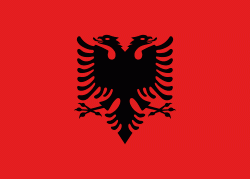Vërnicë (Vernicë)
Vërnicë (Връбница or Върбница, Върмица, Вормица, Врница or Врбница) is a village in the former Trebisht Municipality in Dibër County in northeastern Albania. At the 2015 local government reform it became part of the municipality Bulqizë. It is situated with in the Gollobordë region, near the border with North Macedonia.
A demographic survey of the population of the village, done in 1873, recorded the village as having 30 households with 97 male Bulgarian Christian residents.
In 1900, Vasil Kanchov gathered and compiled statistics on demographics in the area and reported that the village of Varbnitsa was inhabited by about 300 Bulgarian Christians. The "La Macédoine et sa Population Chrétienne" survey by Dimitar Mishev (D. Brankov) concluded that the village was inhabited by 256 Bulgarian Exarchists. There was a Bulgarian school in the beginning of 20th century in Varbnitza.
During the Balkan Wars, two men from the village joined the Macedonian-Adrianopolitan Volunteer Corps.
Elez Koçi was killed in the village in 1916 by Bulgarian forces.
In 1939, on behalf of 40 Bulgarian houses in Varbitsa Kuzman Strezov signed a request by the local Bulgarians to the Bulgarian tsaritsa Giovanna requesting her intervention for the protection of the Bulgarian people in Albania - at that time an Italian protectorate.
According to some sources instruction in Macedonian was permitted in Vërnicë during the late 1940s.
A demographic survey of the population of the village, done in 1873, recorded the village as having 30 households with 97 male Bulgarian Christian residents.
In 1900, Vasil Kanchov gathered and compiled statistics on demographics in the area and reported that the village of Varbnitsa was inhabited by about 300 Bulgarian Christians. The "La Macédoine et sa Population Chrétienne" survey by Dimitar Mishev (D. Brankov) concluded that the village was inhabited by 256 Bulgarian Exarchists. There was a Bulgarian school in the beginning of 20th century in Varbnitza.
During the Balkan Wars, two men from the village joined the Macedonian-Adrianopolitan Volunteer Corps.
Elez Koçi was killed in the village in 1916 by Bulgarian forces.
In 1939, on behalf of 40 Bulgarian houses in Varbitsa Kuzman Strezov signed a request by the local Bulgarians to the Bulgarian tsaritsa Giovanna requesting her intervention for the protection of the Bulgarian people in Albania - at that time an Italian protectorate.
According to some sources instruction in Macedonian was permitted in Vërnicë during the late 1940s.
Map - Vërnicë (Vernicë)
Map
Country - Albania
 |
 |
| Flag of Albania | |
Albania has been inhabited by different civilisations over time, such as the Illyrians, Thracians, Ancient Greeks, Romans, Byzantines, Venetians, and Ottomans. The Albanians established the autonomous Principality of Arbër in the 12th century. The Kingdom of Albania and Principality of Albania formed between the 13th and 14th centuries. Prior to the Ottoman conquest of Albania in the 15th century, the Albanian resistance to Ottoman expansion into Europe led by Skanderbeg won them acclaim over most of Europe. Albania remained under Ottoman rule for nearly five centuries, during which many Albanians (known as Arnauts) attained high-ranking offices in the empire, especially in the Southern Balkans and Egypt. Between the 18th and 19th centuries, cultural developments, widely attributed to Albanians having gathered both spiritual and intellectual strength, conclusively led to the Albanian Renaissance. After the defeat of the Ottomans in the Balkan Wars, the modern nation state of Albania declared independence in 1912. In the 20th century, the Kingdom of Albania was invaded by Italy, which formed Greater Albania before becoming a protectorate of Nazi Germany. Enver Hoxha formed the People's Socialist Republic of Albania after World War II, modeled under the terms of Hoxhaism. The Revolutions of 1991 concluded the fall of communism in Albania and eventually the establishment of the current Republic of Albania.
Currency / Language
| ISO | Currency | Symbol | Significant figures |
|---|---|---|---|
| ALL | Albanian lek | L | 2 |
| ISO | Language |
|---|---|
| SQ | Albanian language |
| EL | Greek language |















